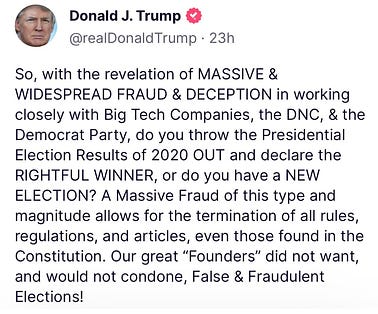Does He Actually Have to Shoot Someone on Fifth Avenue?
Electing a representative to any prominent position in government requires projection, the ability to imagine, at least deep down somewhere, that the person for whom you cast your ballot shares your values, that they will study the issues (just like you would—if you only had the time and interest), and that they will vote in government the way you would vote.
It follows that being a successful politician requires that one studiously avoids taking any stand that might alienate any block of voters upon whom you depend to win the next election. There are two corollaries:
- Every politician will quietly rejoice when the media (and their voters) don’t ask the hard questions at all. This is the issue addressed in this email.
- The best of circumstances arises once you’ve figured out a messaging means, like McMorris Rodgers’ targeted emails, of fostering your extremist voters ability to project while independents and less extreme voters can discount or totally ignore the message you feed your extremist wing.
Last Friday, the leader of the Republican Party, the presumed frontrunner for the Republican nomination for President in 2024, and, so far, the only declared candidate, Donald Trump, declared on his “Truth Social” social media site that such “Massive Fraud” had occurred in the 2020 election that it justified “termination of all rules, regulations, and articles, even those found in the Constitution”. Here’s the full message, lest anyone wonder if the quote were taken out of context:

Absorb that: former President called to “terminate…the Constitution”. The context was his effort to play up a nothing-burger about the 2020 election pushed by Elon Musk on his newly-purchased Twitter platform. (The best write-up of that context [and why it’s a nothing-burger] that I’ve seen is Robert Hubbell’s “What the heck just happened?)
Those of us who read Hubbell’s Today’s Edition Newsletter or Joyce Vance’s Civil Discourse or Heather Cox Richardson’s Letters from an American (or all three) were apprised of Trump’s plea to put aside the rules and regulations of the U.S. Constitution, make him President once again, and the details of the Twitter context that elicited his outburst. Were independents and political moderates made aware of Trump’s outrageous sedition by the standard media?
The headline of the Spokesman article covering Trump’s statement? “White House rebukes Trump’s suggestion to suspend Constitution over 2020 election” was buried on page A13 in the lower right hand column in the Sunday, December 4th, Spokesman—an article purchased from the Washington Post. The headline was NOT “Trump calls to suspend the U.S. Constitution”. Instead, the headline hints at a minor tiff between the White House and the former President.
This takes us back to politicians and projection. If the average citizen isn’t even aware of Trump’s sedition (See P.S.) one cannot expect the average Republican politician to step up and call it out. After all, if, like “our” McMorris Rodgers (U.S. Representative from CD5, eastern Washington), a significant portion of your voting base thinks Trump is a virtual deity, you will wish for Trump’s words to be buried, and, if confronted, you will do anything you can to weasel out of issuing a direct repudiation. Surely you will not volunteer a statement unless you are hard-pressed.
Every time McMorris Rodgers’ name appears in electrons in the media I receive a “Google Alert” email. I waded through all nineteen “Alerts” dated after Trump’s sedition. Did she comment? Crickets. Statement on her website? Nothing. If she, and other Republicans, are not pressed hard for answers they will ignore the sedition of their presumptive leader and move on as if nothing had happened.
There are several things you can do: 1) Add you name with mine to this petition on Change.org 2) Call McMorris Rodgers’ local Post Street office at 509-353-2374 and ask for her comment 3) Or take this advice from Joyce Vance:
Let’s keep the heat on them this week and for as long as it takes. You can call (202) 224-3121 and ask to speak with your senators and representatives. Don’t forget email, postcards, letters and calls to district offices too, in addition to social media and requests for in-person meetings. They’ll be keeping track of the calls and other incoming messages this week. Sometimes they need to be reminded that they work for us, and that no matter how difficult they make it, we’re committed to voting in our elections to keep it that way.
Keep to the high ground,
Jerry
P.S. From wikipedia (the italics are mine): Sedition is overt conduct, such as speech and organization, that tends toward rebellion against the established order. Sedition often includes subversion of a constitution and incitement of discontent toward, or insurrection against, established authority. Sedition may include any commotion, though not aimed at direct and open violence against the laws.